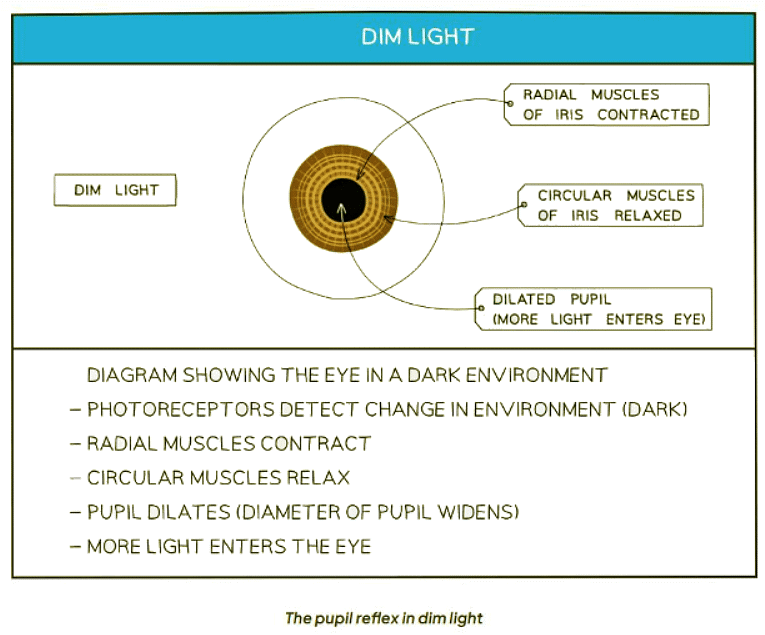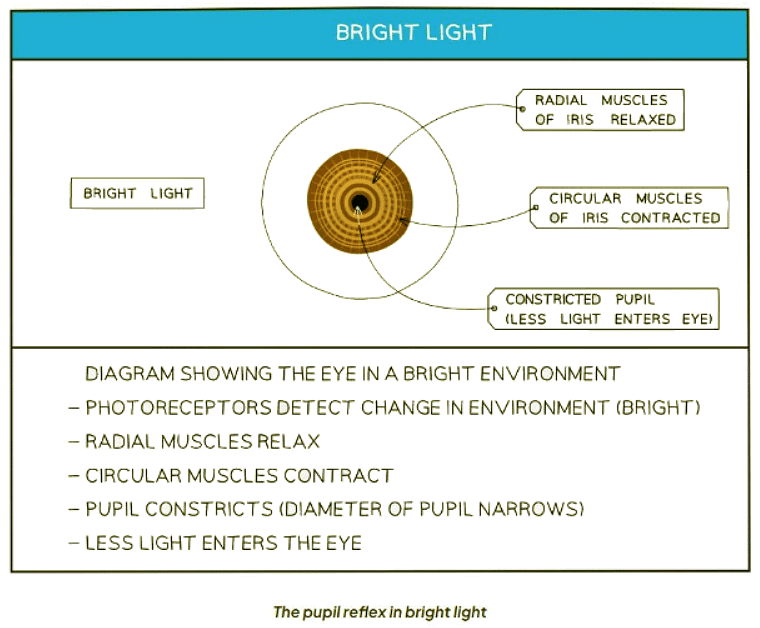Class 10 Exam > Class 10 Notes > Biology for GCSE/IGCSE > The Eye
The Eye | Biology for GCSE/IGCSE - Class 10 PDF Download
| Table of contents |

|
| Structure & Function of the Eye |

|
| The Pupil Reflex - Antagonistic Muscle Action |

|
| Accommodation |

|
| Rod & Cone Cells |

|
Structure & Function of the Eye
- The eye, a sensory organ, holds receptor cells that detect light (rod cells) and color (cone cells).
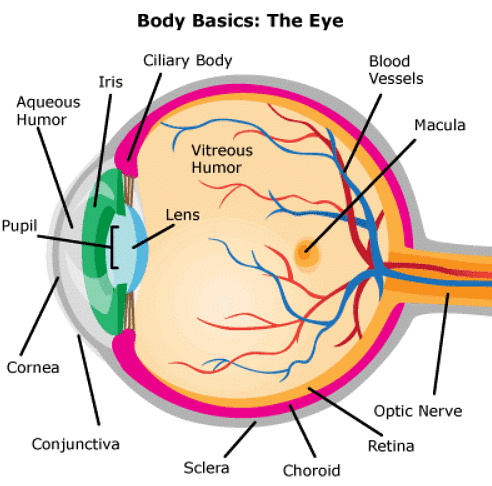
Function of the parts of the eye:
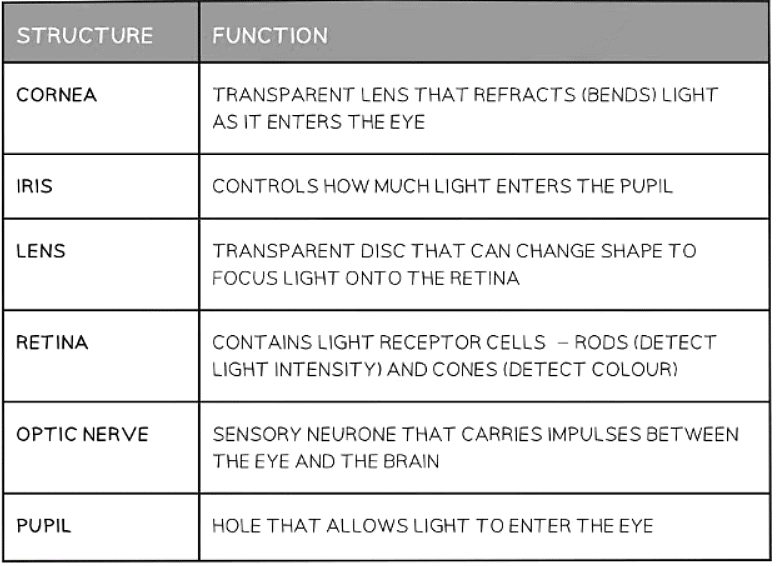
The Blind Spot
- At the point where the optic nerve joins the retina, there are no light-sensitive rod and cone cells on that part of the retina
- Light falling onto that part of the retina will not result in an image being detected. The brain 'fills in' from surrounding light so we don't see a black hole where no light has fallen.
- The brain processes visual information by 'filling in' from surrounding light to prevent the perception of black holes where no light has fallen.
- As a result of this process, a blind spot is created in our peripheral vision, rendering us unable to detect objects even if they are present.
The Pupil Reflex
- This is a reflex action carried out to protect the retina from damage in bright light and protect us from not seeing objects in dim light
- In dim light the pupil dilates (widens) in order to allow as much light into the eye as possible
- In bright light the pupil constricts (narrows) in order to prevent too much light entering the eye and damaging the retina
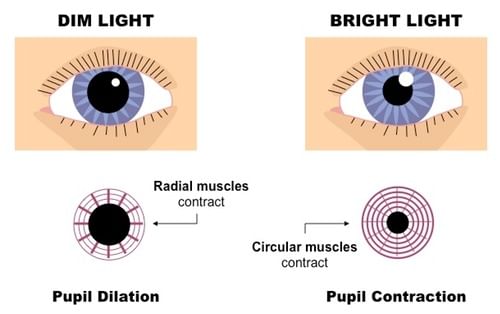
- In dim lighting conditions, the pupil dilates, enlarging to permit more light to enter the eye, thus enhancing vision.
- Conversely, in bright environments, the pupil constricts, shrinking to reduce the amount of light entering the eye and safeguarding the retina from potential damage.
The Pupil Reflex - Antagonistic Muscle Action
- The pupil reflex involves two sets of muscles, the radial muscles, and the circular muscles, which work in opposition to each other to control the amount of light entering the eye.
- Radial muscles dilate the pupil, allowing more light to enter, while circular muscles constrict the pupil, reducing the amount of light entering the eye.
- When radial muscles contract, circular muscles relax, and vice versa, demonstrating antagonistic action.
Accommodation
Accommodation: The function of the eye in focusing on near and distant objects
- The process by which the lens adjusts to bring objects into focus is known as accommodation.
- The lens is flexible and can change its shape based on the tightness or looseness of the suspensory ligaments attached to it.
- Key Terms: flexible, suspensory ligaments, tight, loose
- Changes in the lens shape are controlled by the contraction or relaxation of the ciliary muscles.
- When an object is near, the ciliary muscles contract, reducing the diameter of the muscle ring.
- When an object is close up:
- The ciliary muscles contract, causing the suspensory ligaments to loosen.
- This relaxation prevents the suspensory ligaments from tugging on the lens, allowing it to thicken.
- As a result, light gets refracted more effectively.
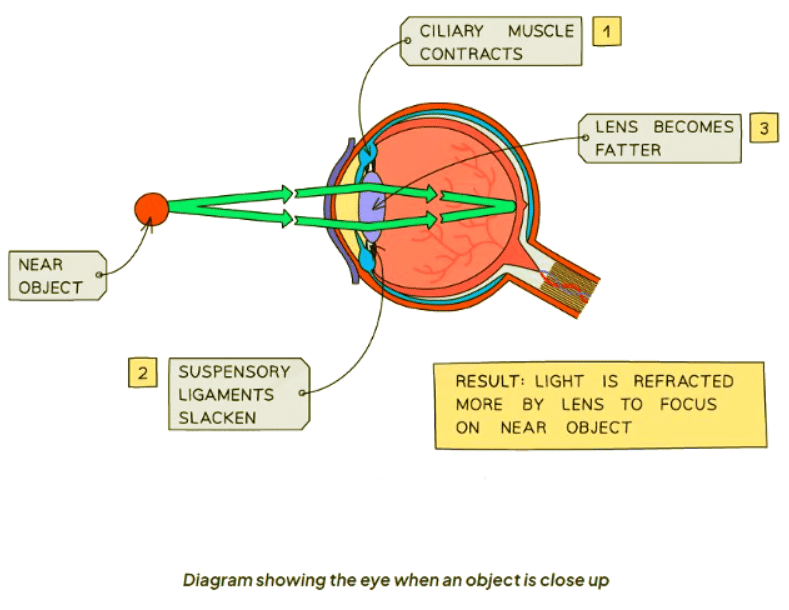
When an object is far away:
- The ciliary muscles relax, causing the suspensory ligaments to tighten.
- This tension makes the suspensory ligaments pull on the lens, resulting in its thinning.
- Consequently, light is refracted less compared to when the object is closer.

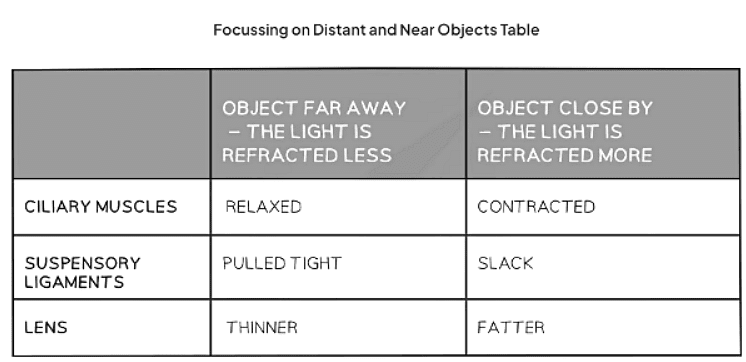
Rod & Cone Cells
- There are two main types of cells in the retina responsible for detecting light:
- Rods: These cells are highly sensitive to low light conditions.
- Cones: These cells are specialized in distinguishing between different colors, especially in bright light.
- Rods and cones have distinct functions:
- Rods are primarily activated in dim light situations.
- Cones come into play in bright light, allowing us to perceive a wide range of colors.
- Cones further specialize into three subtypes, each sensitive to a particular color of light:
- Red-sensitive cones
- Blue-sensitive cones
- Green-sensitive cones
- The fovea, a central area on the retina, contains a high density of cone cells, facilitating detailed color vision.
- Rod cells are spread throughout the retina except for the optic nerve's point of attachment, creating a region known as the blind spot:
- The blind spot lacks light-sensitive cells, making it unable to detect light or color.
- In low light conditions, such as during night vision, only rod cells are stimulated, resulting in black and white vision.
Question for The EyeTry yourself: What is the function of the blind spot in the eye?View Solution
The document The Eye | Biology for GCSE/IGCSE - Class 10 is a part of the Class 10 Course Biology for GCSE/IGCSE.
All you need of Class 10 at this link: Class 10
|
101 videos|193 docs|33 tests
|
Related Searches

